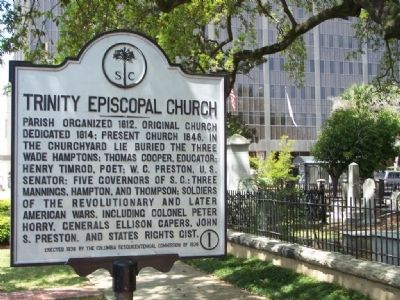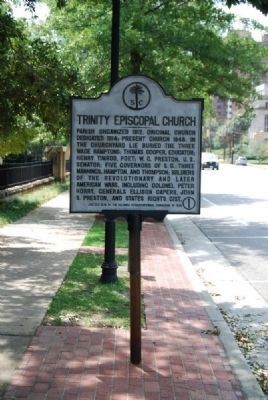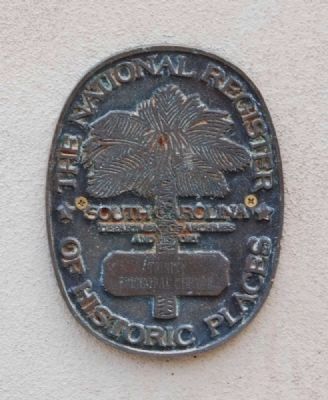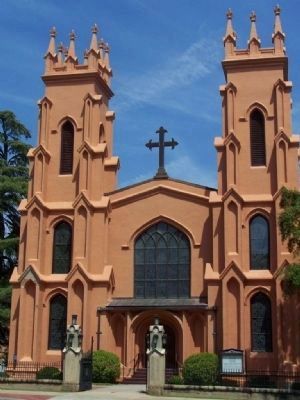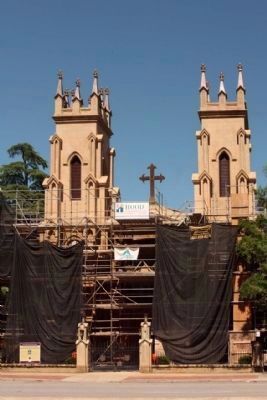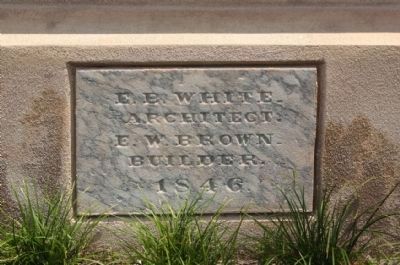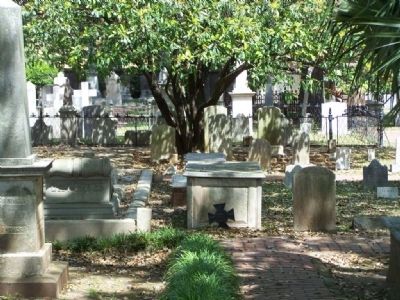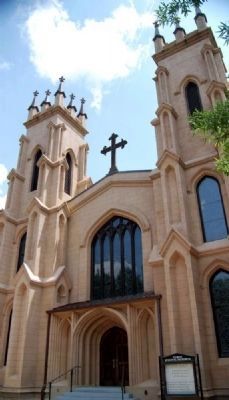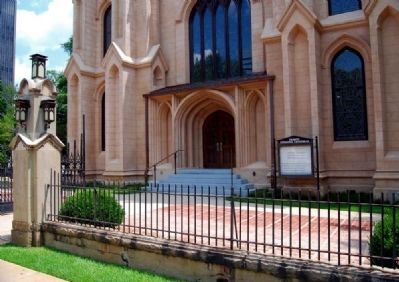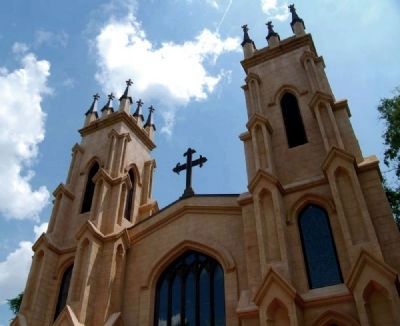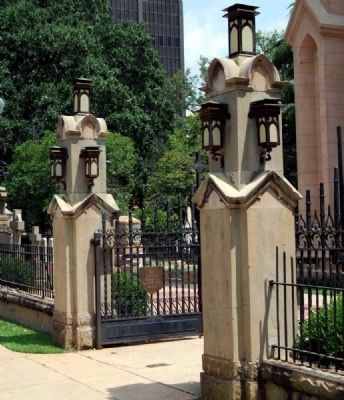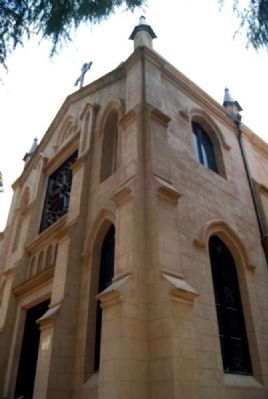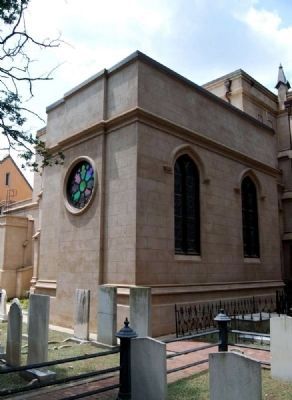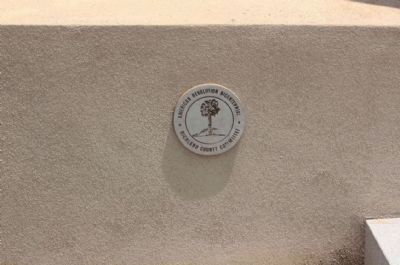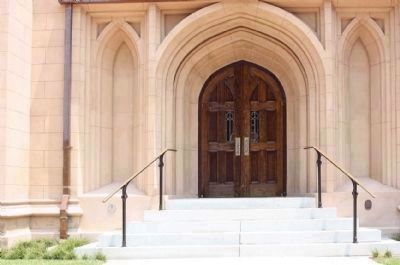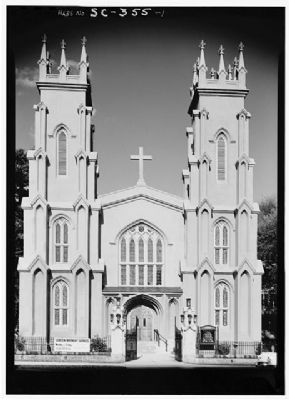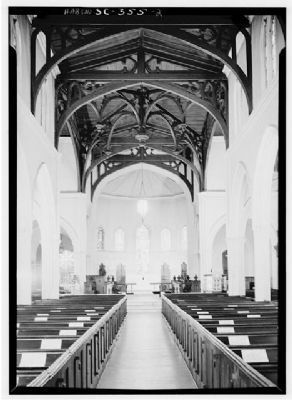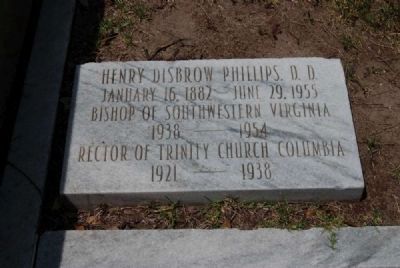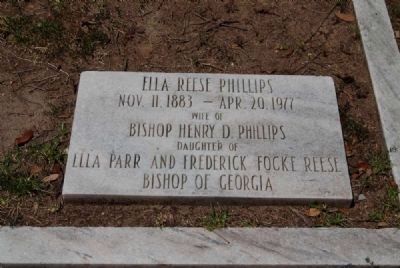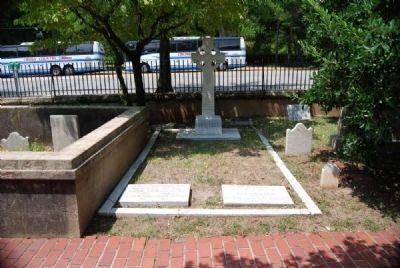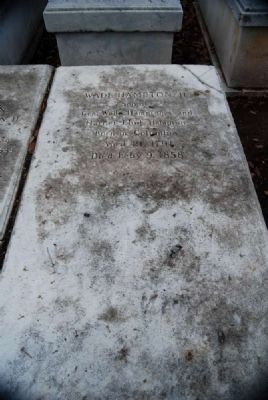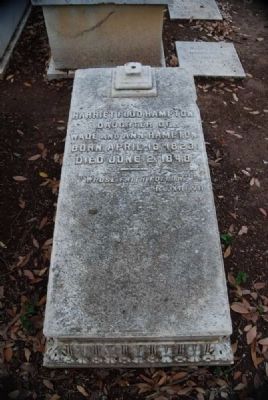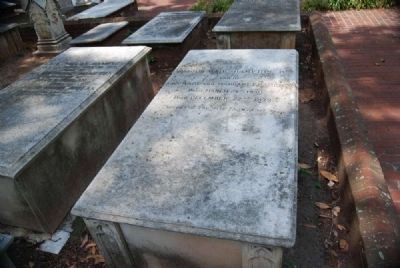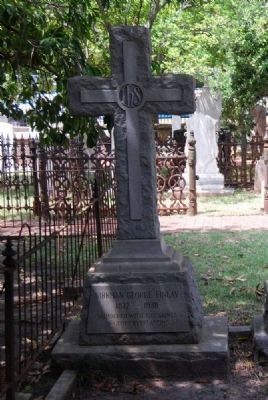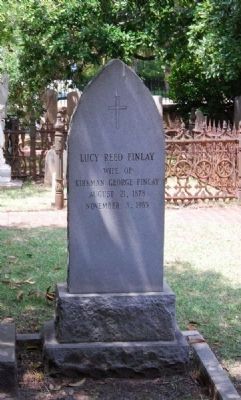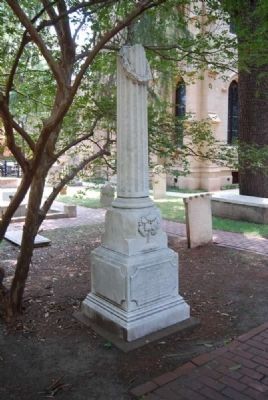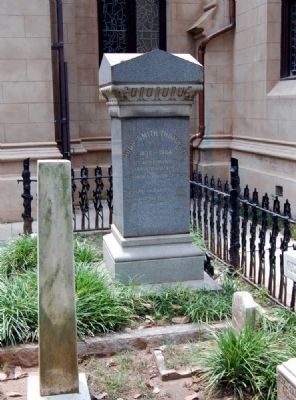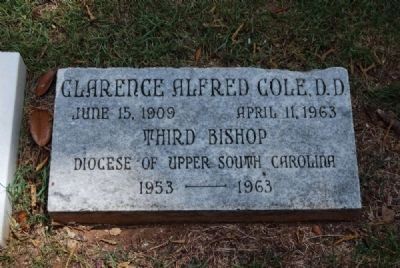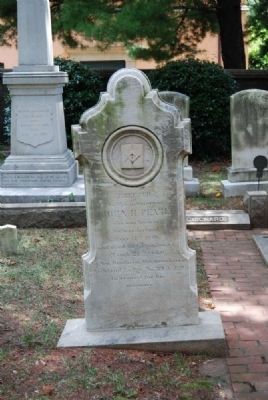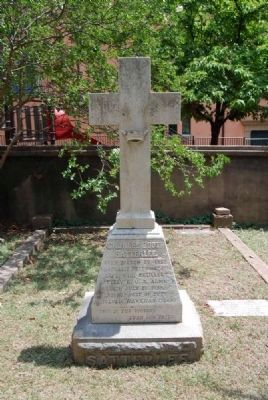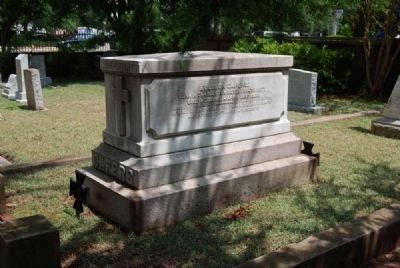Midtown - Downtown in Columbia in Richland County, South Carolina — The American South (South Atlantic)
Trinity Episcopal Church
Parish organized 1812. Original Church dedicated 1814; Present church 1846. In the churchyard lie buried three Wade Hamptons; Thomas Cooper, Educator; Henry Timrod, Poet; W.C. Preston, U.S. Senator; Five Governors of S.C.: Three Mannings, Hampton and Thompson; Soldiers of the Revolutionary and later American Wars, including Colonel Peter Horry, Generals Ellison Capers, John S. Preston and States Rights Gist.
Erected 1938 by The Columbia Sesquicentennial Commission of 1936. (Marker Number 40-1.)
Topics. This historical marker is listed in these topic lists: Cemeteries & Burial Sites • Churches & Religion • War, US Revolutionary. A significant historical year for this entry is 1812.
Location. 34° 0.064′ N, 81° 1.895′ W. Marker is in Columbia, South Carolina, in Richland County. It is in Midtown - Downtown. Marker is on Sumter Street, on the left when traveling south. Opposite East side of State House Grounds. Touch for map. Marker is at or near this postal address: 1100 Sumter Street, Columbia SC 29201, United States of America. Touch for directions.
Other nearby markers. At least 10 other markers are within walking distance of this marker. Trinity Church (a few steps from this marker); Memory of South Carolina Generals (within shouting distance of this marker); Wade Hampton (within shouting distance of this marker); Henry Disbrow Phillips, D.D. (within shouting distance of this marker); James F. Byrnes (within shouting distance of this marker); Senate Street (within shouting distance of this marker); Sumter Street (about 300 feet away, measured in a direct line); Gonzales Tribute (about 300 feet away); African-American History Monument (about 300 feet away); Battleship Maine Memorial (about 300 feet away). Touch for a list and map of all markers in Columbia.
Regarding Trinity Episcopal Church. Trinity Episcopal Church’s chief significance is architectural. It was designed ca. 1840 by Edward Brickell White, who also designed the steeple of St. Philip’s Church and Grace Church in Charleston. Modeled after Yorkminster Cathedral in England, the church is an example of English Gothic Revival style with a cruciform shape, two ornate front towers, arched oak doors, and four-shouldered buttresses. It is one of the earliest examples of ecclesiastical Gothic architecture in the South. Most of its stained glass windows were imported from Munich ca. 1860 and its marble baptismal font was designed by Hiram Powers. Founded in 1812, the first frame church building was completed in 1814. The present building was begun in 1845 and finished in present form 1894. The towers and nave were constructed first, with the transepts added and chancel extended in 1861-1862 under White’s direction. The church escaped burning in 1865 by General W.T. Sherman, who was a Roman Catholic, by the removal of its “Episcopal” signs, and the placing of papier-mâché crosses on the edges of its roof. Buried in its adjacent historic graveyard are five South Carolina governors, two Revolutionary War officers, three Confederate generals, the poet Henry Timrod, the three Wade Hamptons, surveyor John Gabriel Guignard, and Dr. Thomas Cooper. Listed in the National Register February 24, 1971.(South Carolina Department of Archives and History)
National Register of Historic Places:
Trinity Episcopal Church ** (added 1971 - - #71000805)
1100 Sumter St. , Columbia
♦ Historic Significance: Event, Architecture/Engineering
♦ Architect, builder, or engineer: White, Edward Brickell
♦ Architectural Style: Gothic
♦ Area of Significance: Architecture, Religion
♦ Period of Significance: 1875-1899, 1850-1874, 1825-1849
♦ Owner: Private
♦ Historic Function: Religion
♦ Historic Sub-function: Religious Structure
♦ Current Function: Religion
♦ Current Sub-function: Religious Structure
_M.S._
Also see . . .
1. Trinity Episcopal Cathedral. On February 17, 1865, the troops of General William Tecumseh Sherman entered the city. The next morning, one-third of Columbia was in ashes. The fires raged all around Trinity, but miraculously the church was spared. (Submitted on May 7, 2008, by Mike Stroud of Bluffton, South Carolina.)
2. Trinity Episcopal Church. Trinity Episcopal Church’s chief significance is architectural. (Submitted on July 27, 2011, by Brian Scott of Anderson, South Carolina.)
3. Wade Hampton I. Wade Hampton (1752 – February 4, 1835) was a South Carolina soldier, politician, two-term U.S. Congressman, and wealthy plantation owner. (Submitted on July 27, 2011, by Brian Scott of Anderson, South Carolina.)
4. Wade Hampton II. Wade Hampton II (April 21, 1791 – February 10, 1858) was an American plantation owner and soldier in the War of 1812. (Submitted on July 27, 2011, by Brian Scott of Anderson, South Carolina.)
5. Wade Hampton III. Wade Hampton III (March 28, 1818 – April 11, 1902) was a Confederate cavalry leader during the American Civil War and afterward a politician from South Carolina, serving as its 77th Governor and as a U.S. Senator. (Submitted on July 27, 2011, by Brian Scott of Anderson, South Carolina.)
6. Thomas Cooper. Thomas Cooper (October 22, 1759 – May 11, 1839) was an American economist, college president and political philosopher. (Submitted on July 27, 2011, by Brian Scott of Anderson, South Carolina.)
7. Henry Timrod. Henry Timrod (December 8, 1828 - October 7, 1867) was an American poet, often called the poet laureate of the Confederacy. (Submitted on July 27, 2011, by Brian Scott of Anderson, South Carolina.)
8. William C. Preston. William Campbell Preston (December 27, 1794 – May 22, 1860) was a senator from the United States and a member of the Nullifier, and later Whig Parties. (Submitted on July 27, 2011, by Brian Scott of Anderson, South Carolina.)
9. Peter Horry. Peter Horry (1743 or 1747 – 28 February 1815) was a South Carolina militia leader. (Submitted on July 27, 2011, by Brian Scott of Anderson, South Carolina.)
10. Ellison Capers. Ellison Capers (October 14, 1837 – April 22, 1908) was a school teacher, Confederate general in the American Civil War, theologian, and college administrator from South Carolina. (Submitted on July 27, 2011, by Brian Scott of Anderson, South Carolina.)
11. John S. Preston. John Smith Preston (April 20, 1809 – May 1, 1881) was a wealthy planter, soldier, and attorney who became prominent in South Carolina politics in the 19th century. (Submitted on July 27, 2011, by Brian Scott of Anderson, South Carolina.)
12. States Rights Gist. States Rights Gist (September 3, 1831 – November 30, 1864) was a lawyer, a militia general in South Carolina, and a Confederate Army brigadier general who served during the American Civil War. (Submitted on July 27, 2011, by Brian Scott of Anderson, South Carolina.)
Additional commentary.
1. Trinity Episcopal Church - National Register Nomination Form (1970)
Description
Buff-plastered English Gothic Revival style with arched oak doors; ornate twin towers each supporting eight pinnacles with fleur de lis ornaments. Designed 1840 by Charleston architect Edward Brickwell White, church has cruciform shape, four-shouldered buttresses, ornamented pinnacles along edges of roof. Transepts added and chancel extended 1861-1862 under White's direction. Most stained glass windows, including rose windows in transepts, imported from Munich c. 1860. Second building begun 1845 to replace frame church built 1814. Towers and nave constructed first; finished in present form 1894.
Inside church is marble baptismal font designed by Hiram Powers. Wooden roof on hammer-beam trusses. Box pews, brass
pulpit, tiled floor in sanctuary, marble chancel rail, and handcarved walnut choir stalls. Only church in city with clerestory. Large memorial stained glass window commemorates Peter Shand, pastor from 1834-1886, above white marble alter. smaller windows above columned arcades in clerestory.
Wrought iron fencing and gates surround church and graveyard.
Significance
Trinity Episcopal Church’s chief significance is architectural. It was designed by Edward Brickell White, who also designed the steeple of St. Philip’s Church, the Huguenot Church, and Grace Church in Charleston. Of English Gothic Revival style with two ornate front towers, arched oak doors, and four-shouldered buttresses, it was modeled after Yorkminster Cathedral in England. It is one of the earliest examples of ecclesiastical Gothic architecture in the South. Its stained glass windows, except for a few memorials, were imported from Munich ca. 1860, and its marble baptismal font was designed by Hiram Powers.
Founded in 1812, the first Trinity church building was completed in 1814 on lands donated by Gen. C.C. Pinckney, Elias Horry, and Peter Smith of Charleston, and the South Carolina legislature. Its first pastor, Rev. Christian Hanckell, (1815-1821) was also a professor of mathematics and natural philosophy at the South Carolina College during the early years of his ministry.
After the Civil War he became state agent of the Episcopal Freedmans Aid Commission, which distributed money raised in the north to newly emancipated southern blacks. The church escaped burning in 1865 by Sherman, who was a Roman Catholic, by the removal, it is said, of its "Episcopal" signs, and the placing of paper mache crosses on the edges of its roof. From 1834 to 1888 its pastor was Peter Shand, under whose leadership the congregation quintupled. By 1938 Trinity had the largest Episcopal congregation in the state.
In its adjacent historic graveyard are buried five South Carolina governors, two Revolutionary War officers, three Confederate generals, the poet Henry Timrod, the three Wade Hamptons, John Gabriel Guignard, surveyor of Columbia, and Dr. Thomas Cooper, controversial nationally-known president of South Carolina College, and close friend of Thomas Jefferson.
In 1962 the American House of Bishops, compromised of all the Episcopal bishops in the United States, met at Trinity. The bishops were addressed by Arthur Michael Ramsey, archbishop of Canterbury.
— Submitted July 28, 2011, by Brian Scott of Anderson, South Carolina.
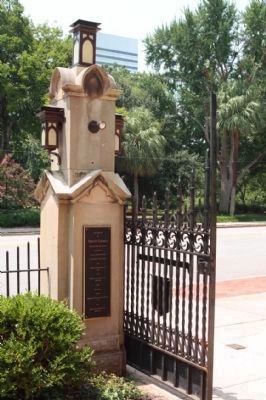
Photographed By Mike Stroud
12. Trinity Episcopal Church Timeline
as
Trinity Church
The First Episcopal Church
Established
In South Carolina After
The American Revolution
+++
This Structure Erected
1846
and
Enlarged and Remodeled
1860-1862
+++
Cathedral
The
Diocese of Upper South Carolina
1977
+++
Bicentennial Restoration
2007-2010
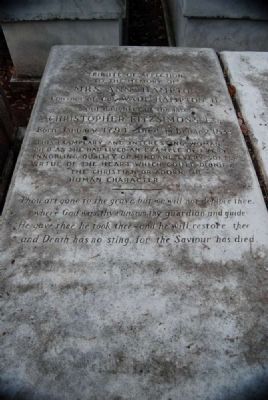
Photographed By Brian Scott, July 25, 2011
23. Ann Hampton Tombstone
to the Memory of
Mrs. Ann Hampton
Consort of Col. Wade Hampton II
and daughter of the late
Christopher Fitzsimmons, Esq.
Born January 1794-Died February 1833
This exemplary and interesting woman
died as she had lived an example of every
ennobling quality of mind and every softer
virtue of the heart which could dignify
the Christian or adorn the
human character.
----------
Thou are gone to the grave, but we will not deplore thee
where God was the ransom thy guardian and guide
He have thee, he took thee - and he will restore thee
and Death has no sting, for the Saviour has died.
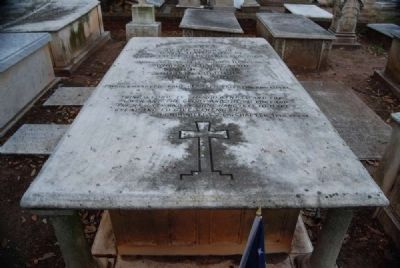
Photographed By Brian Scott, July 25, 2011
25. Wade Hampton III Tombstone
to the Memory of
Wade Hampton III
1861 Lieut General C.S.A. 1865
Son of
Wade and Anne Fitzsimons Hampton
Born in Charleston
March 28, 1818
Died in Columbia
April 11, 1902
Whole Hearted, True Hearted, Faithful and Loyal
Thine, O Lord, is the greatness and the
power and the glory and the victory and
the majesty and in thine hand it is to make
great and to give strength.
I Chronicles 29th Chapter 11th Verse
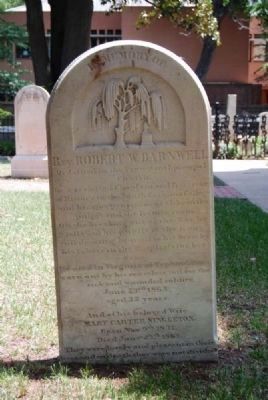
Photographed By Brian Scott, July 25, 2011
30. Rev. Robert W. and Mary S. Barnwell Tombstone
Rev. Robert W. Barnwell
Ordained in the Protestant Episcopal Church,
he was elected Chaplin and Professor
of History to the South Carolina College
and became pre-eminent alike in the
pulpit and the lecture room.
On the breaking out of the War he
followed his pupils to the front
still devoting himself to his State by
his labors in the Hospitals for her Sons.
He died in Virginia of Typhoid Fever,
worn out by his ceaseless toil for the
sick and wounded soldier.
June 23rd 1863
aged 32 years.
And of his beloved wife
Mary Carter Singleton
Born Nov. 9th 1837
Died June 25th 1863
They were lovely and pleasant in their
lives and in death they were not divided.
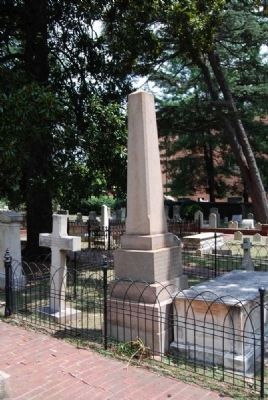
Photographed By Brian Scott, July 25, 2011
31. Maximilian LaBorge
graduated at S.C. College 1820
Received Degree of M.D. from
Medical College of Charleston
1826. Chosen a member of
House of Representatives 1838.
Elected Secretary of State 1839.
Professor in S.C. College 1847-1873.
Vestryman of Trinity Church 1842-
1873. Established Wayside Hospitals
in Va. 1861. Chairman of Central
Association for Relief of S.C.
Soldiers 1862-1865. Died at S.C.
College Nov. 6, 1873.
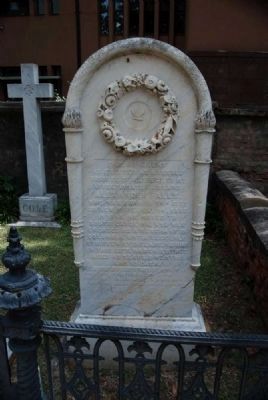
Photographed By Brian Scott, July 25, 2011
34. Alexander Falls Tombstone
is erected as a feeble
tribute of respect to my
affectionate husband
Alexander Falls
who was born in the City
of New York July 14, 1812.
In 1845, he moved to
South Carolina, and was
engaged as a merchant in
Columbia, until suddenly
stricken by disease. He died
in this city March 27, 1862
aged 49 years, 8 months
and 13 days.
I know thou art gone to the home of thy rest,
Then why should my soul be so sad!
I know thou art gone where the weary are blest
And I hope! though I mourn and am glad.
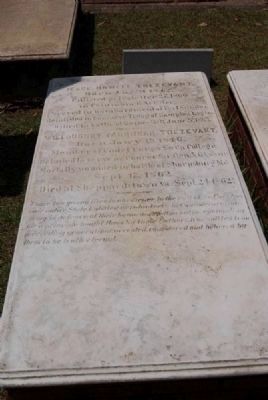
Photographed By Brian Scott, July 25, 2011
37. Jesse Howell Trezevant/Willoughby Farqunar Trezevant Tombstone
Born Aug. 31, 1842
Enlisted private Dec. 27, 1860
in Columbia E Artillery
Served in bombardment of Fort Sumter
Reenlisted in Congaree Troop of Hampton Legion Killed in Battle of Gaines Mill June 27, 1862.
----------
Willoughby Farqunar Trezevant
Born Jan'y 19, 1846
Member of Cadet Corps So.Ca.Col.
Detailed to serve as Courier for Gen. N.G. Evans
Mortally wounded in battle of Sharpsburg, Md.
Sept. 17, 1862
Died at Sheppardstown, Va., Sept. 24, 1862.
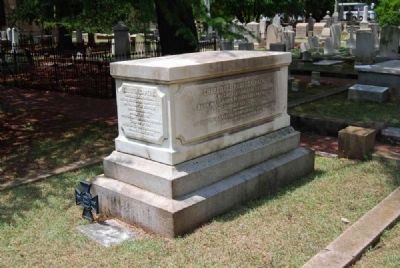
Photographed By Brian Scott, July 25, 2011
39. Ellison and Rebecca Capers Tombstone
Southwest Corner
Southwest Corner
Brigadier General
in the Southern Confederacy
Secretary of State of
South Carolina
Priest of the
Protestant Episcopal Church
Bishop of the
Diocese of South Carolina
Chancellor of the
University of the South
Charlotte Rebecca
Wife of Ellison Capers
Born in St. John's Parish February 11th 1837
Died in Columbia August 13th 1908
----------
Looking unto Jesus she glorified every relationship in
life, being faithful unto death.
Credits. This page was last revised on December 30, 2023. It was originally submitted on May 7, 2008, by Mike Stroud of Bluffton, South Carolina. This page has been viewed 1,854 times since then and 29 times this year. Last updated on September 8, 2008, by Brian Scott of Anderson, South Carolina. Photos: 1. submitted on May 7, 2008, by Mike Stroud of Bluffton, South Carolina. 2, 3. submitted on July 27, 2011, by Brian Scott of Anderson, South Carolina. 4. submitted on May 7, 2008, by Mike Stroud of Bluffton, South Carolina. 5. submitted on May 9, 2010, by Mike Stroud of Bluffton, South Carolina. 6. submitted on August 24, 2011, by Mike Stroud of Bluffton, South Carolina. 7. submitted on May 7, 2008, by Mike Stroud of Bluffton, South Carolina. 8, 9, 10, 11. submitted on July 27, 2011, by Brian Scott of Anderson, South Carolina. 12. submitted on July 31, 2011, by Mike Stroud of Bluffton, South Carolina. 13, 14. submitted on July 27, 2011, by Brian Scott of Anderson, South Carolina. 15, 16. submitted on July 31, 2011, by Mike Stroud of Bluffton, South Carolina. 17, 18. submitted on May 8, 2010, by Mike Stroud of Bluffton, South Carolina. 19, 20, 21, 22, 23, 24, 25, 26, 27, 28, 29, 30, 31, 32, 33, 34, 35, 36, 37, 38, 39. submitted on July 27, 2011, by Brian Scott of Anderson, South Carolina. • Craig Swain was the editor who published this page.
